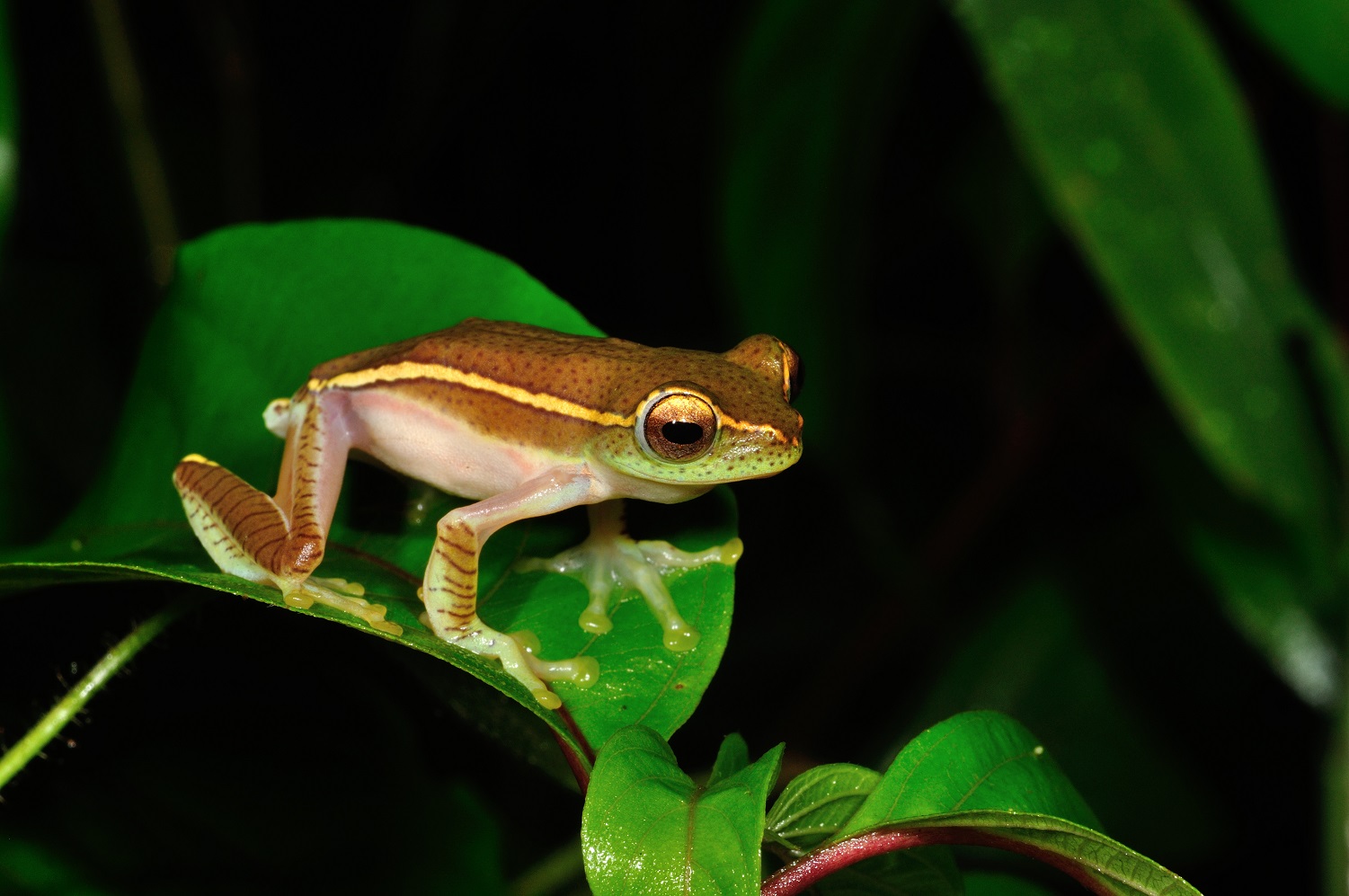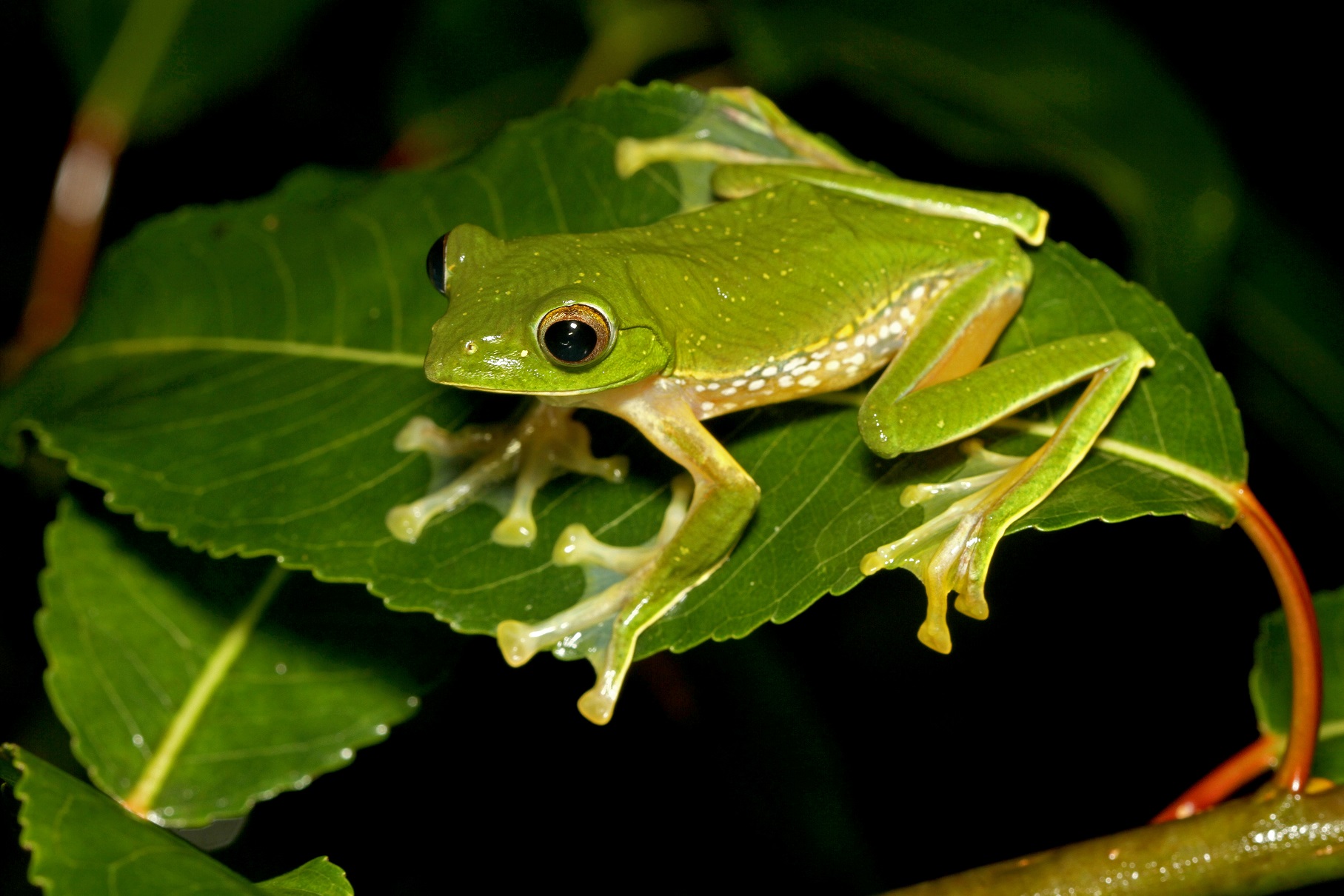If there is one thing that sets frogs apart among all other vertebrates, it is their ability to survive in all habitats except frozen landscapes, seas, and oceans. In the last 360-odd million years that they have lived on this planet, they have transformed from a completely aquatic fish-like animal to their present-day four-legged form. When amphibians began to colonise the land it was presumably teeming with insects. With no dearth of food, over the next million years, the early amphibians began to diversify and occupy different niches. In the rush to do so, one group of frogs ventured into uncharted territory—trees.
Twenty-seven million years ago, in what is known as the Carboniferous period of geological history, there was a proliferation of vegetation on Earth and the rapid diversification of tree frogs in the family Rhacophoridae, coincided with it. All along their journey, frogs could never completely break off their dependence on water, to which even to this day, they return to breed. But living on top of tall trees meant that water was scarce. Climbing up and down the trees to reach water consumes both time and energy. Their ability to glide probably evolved in response to this challenge.
Tree frogs developed extensive webbing between their fingers and toes and used it to parachute from the tops of trees, gaining the name ‘gliding frogs’. But not all tree frogs are known to glide. In a dense forest this is perhaps the most effective way to commute and save energy. So much so that the adaptation to glide has evolved in parallel among mammals, reptiles and even among extinct dinosaurs which gave raise to present day birds. Today, members of the tree frog family are found in Africa, South Asia, China, South East Asia and Japan. In India gliding frogs are restricted to two global biodiversity hotspots: the Western Ghats and the Northeastern Himalayas. The Western Ghats is home to four species of gliding frogs which are found nowhere else on Earth:

The Kalakad gliding frog is named after a forest in Tamil Nadu where it was first found. Measuring about 6 cm from snout to vent, the frog's cryptic colouration allows it to camouflage itself in its wet evergreen forest habitat. Photo: David Raju Cover photo: Dhritiman Mukherjee
Kalakad gliding frog (Rhacophorus calcadensis)
This frog is found in the southern Western Ghats and inhabits wet evergreen forests. First described in 1927, this frog gets its name from the Kalakad forests of the erstwhile Kingdom of Travancore. It measures about 6 cm from snout to vent and has cryptic colouration. The body is greenish with brown granular spots. The underside is pale green, without any prominent markings. Their fingers and toes are fully webbed and a distinct skin fold is seen on the outer edge of the fore and hind limbs. The hind foot has a short spur projecting near the heel. These frogs are excellent climbers and have been seen on trees measuring over 35 m (115 feet) tall. They glide-down from the canopy and lay eggs on vegetation overhanging water. The female deposits eggs in foam like material she creates. The froglets are green and have a red iris, unlike the adult which has ornamentations in the iris.
SPOT THEM: This species is encountered in parts of the Agasthyamalai Biosphere Reserve, especially within the Kalakad Mundanthurai Tiger Reserve in Tamil Nadu.

After it was discovered in 1883, the small gliding frog was lost to science, until it was rediscovered in the forests of Madikeri in the late 1990s. The smallest of the gliding frogs found in the Western Ghats, it measures up to 4 cm. Photo: Dr Seshadri KS
Small gliding frog (Rhacophorus lateralis)
It is the smallest of the four frogs, measuring up to 4 cm. It was described in 1883 and was ‘lost’ for a long time, without any reliable sightings until it resurfaced during the late 1990s in the forests of Madikeri. Adult frogs are about the same length as an adult human thumb and they can be seen on shrubs around small natural pools. The overall green colouration is broken by a bright yellow stripe running laterally from the tip of its snout until the vent. Its legs are long and slender with prominent bars. Small gliding frogs breed during the monsoon and deposit eggs inside a remarkable ‘purse’ made entirely of leaves. After the eggs are deposited and fertilised by her partner the female clasps long and slender leaves and glues them together. The leaves overhang water and when the eggs hatch into tadpoles, they drip down into the shallow pool, where they mature into froglets, only to repeat the cycle again. When the froglets hop out of water, one can see bars on their limbs and spots on their back along with the yellow lateral line.
SPOT THEM: This species can be observed in Coorg, Karnataka and parts of Wayanad in Kerala.

The Malabar gliding frog is the most common of the four species of gliding frogs found in the Western Ghats. Measuring up to 8 cm, the frog is distinguished by the large red-coloured webbing between its yellow-coloured fingers and toes. Photo: David Raju
Malabar gliding frog (R. malabaricus)
The Malabar gliding frog is the most common gliding frog in the Western Ghats, inhabiting diverse habitat ranging from dense evergreen forests to home gardens. This large green frog, measuring up to 8 cm, was first described in the year 1870, and is characterised by large red coloured webbing between yellow-coloured fingers and toes. The frog is green in colour and the underside is ivory white. It has a distinctly pointed snout and a pair of spurs on the heel. The eyes are large and round with yellowish-brown ornamentation. They are often encountered on vegetation around shallow ponds or in water fountains in houses. They can be seen gliding from the tops of trees from early evening into the night. With long slender limbs, they are excellent climbers and can scale small, thin twigs and other such vegetation. Their call is a soft ‘tuck-tuck-tuck’. Females are much larger than males and in the breeding season many males will try to mate with a single female. Like other gliding frogs, the female deposits eggs inside a foam nest. Froglets are green with black spots all over their body.
SPOT THEM: The Malabar gliding frog can be seen all over the Western Ghats.

A resident of the shola forests of the southern Western Ghats, the Anaimalai flying frog looks similar to the Malabar gliding frog, which explains its scientific name 'pseudomalabaricus’. The frog, measuring up to 7 cm, is distinguished by a broad brown stripe with white spots along its flanks. Photo: David Raju
Anaimalai flying frog (R. pseudomalabaricus)
This species is only found in upper montane evergreen forests, also known as the shola forests which occur above 1,000 m elevation in the southern Western Ghats. They look similar to the Malabar gliding frog and hence the name ‘pseudomalabaricus’. Measuring up to 7 cm, this frog has an overall green coloration with a broad brown stripe with white spots along the flanks. The webbing between fingers and toes is yellow in colour. During the breeding season, which coincides with the monsoon, they congregate around artificial ponds or shallow puddles within forests. The female is known to make the foam nest within which she simultaneously deposits eggs. Multiple males try to fertilise the eggs while the female is doing so. The eggs hatch into tadpoles which in turn, metamorphose into froglets that have striking black stripes on their green bodies. The stripes are pale and visible on adults as well.
SPOT THEM: This species has been spotted in the Annamalai Hills and near Idukki in Kerala.
When you are out in the forests of the Western Ghats this monsoon, grab a torch and step out at night and look for these graceful gliders. If you are lucky, one may glide and land right in front of you. You could also go a step further and look after these frogs, for all four species are facing numerous threats from road expansion, tree felling, and land conversion to plantations. If you live in the Western Ghats then perhaps you could help conserve this frog population by maintaining artificial ponds in your backyard and try to prevent the indiscriminate felling of trees. These frogs have survived for millions of years and have seen the dinosaurs come and go. It would be a shame if our actions put an end to their graceful glide through the jungles and through time.